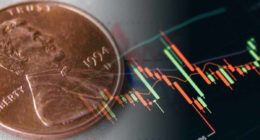U.S. Federal Open Market Committee (FOMC) Meeting Minutes – January 2023
Originally Posted: February 22, 2023, 2 PM ET
Updated: February 22, 2023, 2:22 PM ET
The Federal Open Market Committee’s meeting minutes from the January 2023 Fed meeting are out. It doesn’t matter if you’re trading penny stocks or are trying to make money trading Tesla (NASDAQ: TSLA) or meme stocks like AMC Entertainment (NYSE: AMC), the Fed minutes have a history of sparking volatility in the stock market. Today we get a glimpse of what, if anything else, was said at the first FOMC meeting of 2023. In light of recent inflation data like the January CPI inflation report and PPI report, chances are, these minutes may or may not carry as much weight.
Meanwhile, the FOMC and other global central banks have continued setting expectations for 2023 inflation, rate hikes, and any chance of a “soft landing” that was originally hoped for. As we digest these latest January Fed meeting minutes, let’s also recap the meeting itself.
January 2023 Fed Meeting Recap
When it came to the 2023 January FOMC meeting and it was all about hawkish vs dovish tone, rate of inflation, number of hikes, and the size of those rate hikes. The initial 25 bps hike was expected but recent comments from Fed members have shifted sentiment and focus on the potential of a 50 bps hike at the next Fed meeting. While the next rate hike decision is yet to be seen, we could get some clues from the January 2023 FOMC meeting.
Here are some of the top takeaways from that meeting:
- The Committee decided to raise the target range for the federal funds rate to 4-1/2 to 4-3/4 percent, 25 basis points.
- The Committee reaffirms its judgment that inflation at the rate of 2 percent, as measured by the annual change in the price index for personal consumption expenditures, is most consistent over the longer run with the Federal Reserve’s statutory mandate.
- The longer-term inflation expectations that are well anchored at 2 percent foster price stability and moderate long-term interest rates and enhance the Committee’s ability to promote maximum employment in the face of significant economic disturbances.
- Committee would be prepared to adjust the stance of monetary policy as appropriate if risks emerge that could impede the attainment of the Committee’s goals.
- The Committee anticipates that ongoing increases in the target range will be appropriate in order to attain a stance of monetary policy that is sufficiently restrictive to return inflation to 2 percent over time.
- The Committee will continue reducing its holdings of Treasury securities and agency debt and agency mortgage-backed securities, as described in its previously announced plans.
- Conduct overnight reverse repurchase agreement operations at an offering rate of 4.55 percent and with a per-counterparty limit of $160 billion per day; the per counterparty limit can be temporarily increased at the discretion of the Chair.
- Roll over at auction the amount of principal payments from the Federal Reserve’s holdings of Treasury securities maturing in each calendar month that exceeds a cap of $60 billion per month. Redeem Treasury coupon securities up to this monthly cap and Treasury bills to the extent that coupon principal payments are less than the monthly cap.
- Reinvest into agency mortgage-backed securities (MBS) the amount of principal payments from the Federal Reserve’s holdings of agency debt and agency MBS received in each calendar month that exceeds a cap of $35 billion per month.
- Engage in dollar roll and coupon swap transactions as necessary to facilitate settlement of the Federal Reserve’s agency MBS transactions.
Frequently Asked Questions (FAQ) About The Federal Open Market Committee Meeting Minutes
When Are The Fed Minutes Released?
Fed Meeting Minutes are released three weeks after each FOMC meeting.
What Are The Federal Open Market Committee Meeting Minutes?
According to the Federal Open Market Committee, the Fed meeting minutes “provide a timely summary of the discussion during the meeting and the decisions taken at the meeting. The minutes describe the views expressed by policymakers and explain the reasons for the Committee’s decisions. The minutes can help the public interpret economic and financial developments and understand the Committee’s decisions. As an official record of the meeting, the minutes identify all attendees, and provide a complete record of policy actions taken, including the votes by individual members on each policy action.”
FOMC Meeting Minutes for January 2023
On Inflation
Participants saw a number of upside risks surrounding the outlook for inflation stemming from factors abroad, such as China’s relaxation of its zero-COVID policies and Russia’s continuing war against Ukraine.
A few participants remarked that the risks to their inflation outlook had become more balanced. Participants agreed that the risks to the outlook for economic activity were weighted to the downside. Participants noted that sources of such risks included the prospect of unexpected negative shocks tipping the economy into a recession in an environment of subdued growth, the effects of synchronous policy firming by major central banks, and disruptions in the financial system and broader economy associated with concerns that the statutory debt limit might not be raised in a timely manner.
On Economic Outlook
Staff stated “The sluggish growth in real private domestic spending expected this year and the persistently tight financial conditions were seen as tilting the risks to the downside around the baseline projection for real economic activity, and the staff still viewed the possibility of a recession sometime this year as a plausible alternative to the baseline. Moreover, with core PCE price inflation having slowed in recent months, along with the cumulative upward revisions to the core inflation projection over the past year and the expected softening in economic growth, the staff now viewed the risks around the baseline forecast for inflation this year as balanced.”
On Financial Stability
In their discussion of issues related to financial stability, several participants discussed vulnerabilities in the financial system associated with higher interest rates, including the elevated valuations for some categories of assets, particularly in the CRE sector; the susceptibility of some nonbank financial institutions to runs; and the effect of large, unrealized losses on some banks’ securities portfolios. A few participants commented that international stresses had the potential to transmit to the U.S. financial system.
On Monetary Policy
Participants concurred that the Committee had made significant progress over the past year in moving toward a sufficiently restrictive stance of monetary policy. Even so, participants agreed that, while there were recent signs that the cumulative effect of the Committee’s tightening of the stance of monetary policy had begun to moderate inflationary pressures, inflation remained well above the Committee’s longer-run goal of 2 percent, and the labor market remained very tight, contributing to continuing upward pressures on wages and prices. Against this backdrop, and in consideration of the lags with which monetary policy affects economic activity and inflation, almost all participants agreed that it was appropriate to raise the target range for the federal funds rate 25 basis points at this meeting.
However, “A few participants stated that they favored raising the target range for the federal funds rate 50 basis points at this meeting or that they could have supported raising the target by that amount. The participants favoring a 50-basis point increase noted that a larger increase would more quickly bring the target range close to the levels they believed would achieve a sufficiently restrictive stance, taking into account their views of the risks to achieving price stability in a timely way.”
On Policy Outlook
With inflation still well above the Committee’s 2 percent goal and the labor market remaining very tight, all participants continued to anticipate that ongoing increases in the target range for the federal funds rate would be appropriate to achieve the Committee’s objectives. Participants affirmed their strong commitment to returning inflation to the Committee’s 2 percent objective. In determining the extent of future increases in the target range, participants judged that it would be appropriate to take into account the cumulative tightening of monetary policy, the lags with which monetary policy affects economic activity and inflation, and economic and financial developments. Participants observed that a restrictive policy stance would need to be maintained until the incoming data provided confidence that inflation was on a sustained downward path to 2 percent, which was likely to take some time.
January FOMC Policy Action Plan
At the conclusion of the discussion, the Committee voted to authorize and direct the Federal Reserve Bank of New York, until instructed otherwise, to execute transactions in the SOMA in accordance with the following domestic policy directive, for release at 2:00 p.m.:
Effective February 2, 2023, the Federal Open Market Committee directs the Desk to:
- Undertake open market operations as necessary to maintain the federal funds rate in a target range of 4-1/2 to 4-3/4 percent.
- Conduct overnight repurchase agreement operations with a minimum bid rate of 4.75 percent and with an aggregate operation limit of $500 billion; the aggregate operation limit can be temporarily increased at the discretion of the Chair.
- Conduct overnight reverse repurchase agreement operations at an offering rate of 4.55 percent and with a per-counterparty limit of $160 billion per day; the per-counterparty limit can be temporarily increased at the discretion of the Chair.
- Roll over at auction the amount of principal payments from the Federal Reserve’s holdings of Treasury securities maturing in each calendar month that exceeds a cap of $60 billion per month. Redeem Treasury coupon securities up to this monthly cap and Treasury bills to the extent that coupon principal payments are less than the monthly cap.
- Reinvest into agency mortgage-backed securities (MBS) the amount of principal payments from the Federal Reserve’s holdings of agency debt and agency MBS received in each calendar month that exceeds a cap of $35 billion per month.
- Allow modest deviations from stated amounts for reinvestments, if needed for operational reasons.
- Engage in dollar roll and coupon swap transactions as necessary to facilitate settlement of the Federal Reserve’s agency MBS transactions.”
All FOMC members voted for these actions with none voting against.
Reaction In The Stock Market Today
The immediate reaction in the stock market today was relatively muted with a push-pull between bulls and bears. The first move was to the downside, with broader indexes dipping, including the S&P 500 (NYSEARCA:SPY) and Nasdaq ETF (NASDAQ: QQQ). Meanwhile, the overarching focus is on the next round of companies reporting earnings after the market close on Wednesday and before Thursday’s opening bell. Moderna (NASDAQ: MRNA), Alibaba (NYSE: BABA), and Nvidia (NASDAQ: NVDA), for instance, were little changed. As far as first moves go, the January 2023 Fed minutes didn’t have many unexpected items in at first glance. As more detail emerge we will report on them here. However, mentions of “recession” seem to have become a heavier weight on sentiment as the afternoon session continued.







